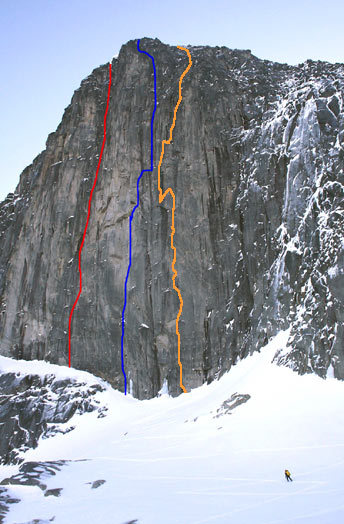
The 450-meter north face of Blamannen, Kvaloya Island, Norway, seen in winter conditions. From left to right: Atlantis (A1/A2 or 5.12c, 400m, Guldal-Nesheim-Nesheim, 1980); Arctandria (A2+ or 5.13d, 450m, Daehli-Nesheim-Nesheim, 1981); Frost (A3 M5, nine pitches, Bo-Nebell, 2007). There are approximately nine routes on the wall with two having been climbed free. [Photo] Bjarte Bo
In the May 2, 2006 NewsWire we reported the first ascent, in winter, of Frost (A3 M5, 9 pitches, Bo-Nebell, 2007) by the well-known Norwegian activists Bjarte Bo and Anne Grete Nebell on the north face of Blamannen. Now, this 450-meter granite wall on the Norwegian island of Kvaloya, close to Tromso, is back in the news courtesy of the very much on form Austrian, Hansjorg Auer. Blamannen, which rises to an altitude of 861 meters, was largely unknown outside Scandanavian circles until recently. It is generally overhanging, compact, solid granite giving well-protected aid routes of around ten to twelve pitches, although one of these, Atlantis (A1/A2, 400m, Guldal- Nesheim-Nesheim, 1980) was climbed free in 1990 by Per Hustad and Johan Nilsson at 5.12c. Possibly the best-looking line lies right of Atlantis. Centered on the wall, Arctandria (A2+), climbed in 1981 by Finn Daehli, Harvard and Sjur Nesheim using copperheads, hooks and knifeblades, was considered at the time to be one of the hardest big wall routes in Norway. Subsequent ascents added some drilled protection, but still the climb has very little fixed gear.
In 2005 Blamannen suddenly gained international prominence after the Swiss, Didier Berthod and Giovanni Quirici, made a free ascent of Arctandria, rating the crux 5.13c. The two climbed the first five pitches on aid, fixed ropes and then spent six separate days working the route. Eventually, both climbers led every pitch. They used natural protection throughout and added no bolts. However, three of the pitches were only pinkpointed, and unsettled weather allowed no opportunity for a single-push ascent. Writing about the experience, Berthod praised the high quality of the climbing and was pleased to be able to climb the route without altering its character by adding bolts: the crux moves are only protected by two copperheads, making it a serious lead. With regard to a single-push ascent he noted, “the challenge is still there.”
Only two months after Auer’s remarkable solo of the Fish on the south face of the Marmolada, he and fellow Austrian Markus Heid took up Berthod’s challenge. Their aim was to climb Arctandria, placing all protection on lead, with both leader and second climbing the route completely free with no falls. After four days of work through unsettled weather (Blamannen is far enough north to get twenty-four hours of daylight during mid summer) the pair made a one-day redpoint on July 15 and upgraded the crux to 5.13d. With pitch grades of 12c, 13d, 12d, 13b, 12b, 13a, 12b, 11d, 11a, 11c and three easy pitches to the summit, Arctandria is one of the hardest multi-pitch, traditionally protected climbs in Europe.